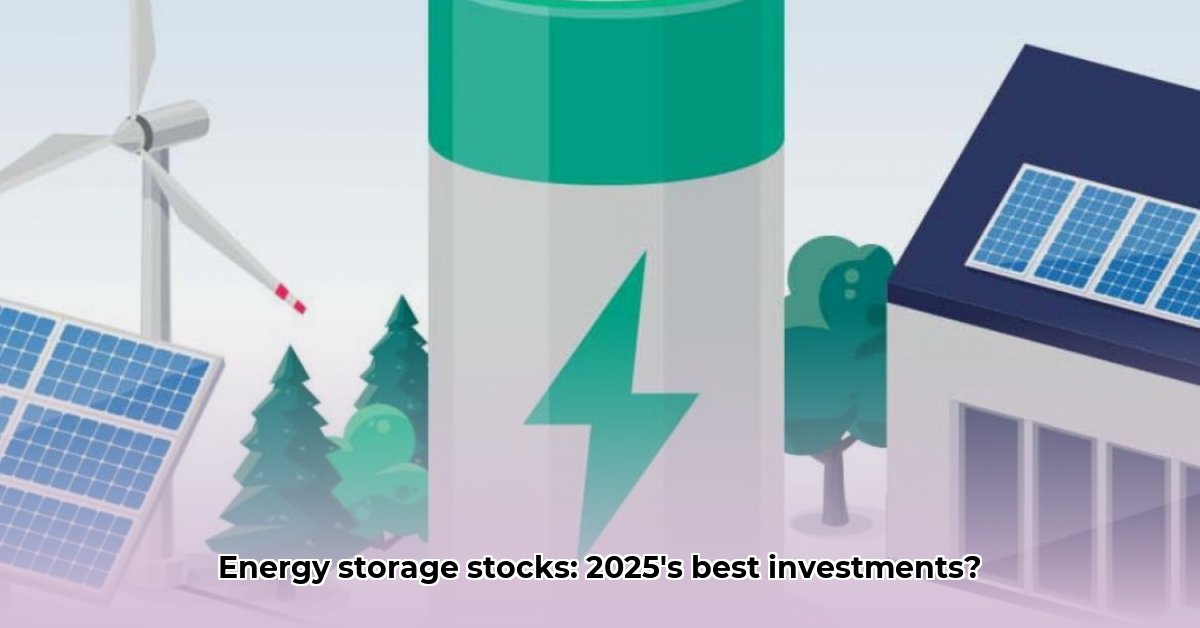
The energy storage sector is poised for explosive growth, presenting lucrative investment opportunities for savvy investors. The world's increasing reliance on renewable energy sources like solar and wind necessitates efficient energy storage solutions to ensure grid stability and reliable power supply. This comprehensive guide will equip you with the knowledge and strategies to navigate this dynamic market and identify promising energy storage stocks, minimizing risk and maximizing returns.
Market Overview: A Booming Sector with Challenges
The energy storage market is experiencing rapid expansion, driven by the increasing adoption of renewable energy and the need for improved grid reliability. This growth is fueled by government incentives promoting clean energy and the inherent intermittency of solar and wind power. However, challenges remain. Supply chain vulnerabilities, particularly concerning lithium, a crucial component in many battery technologies, pose a significant risk. Technological hurdles and regulatory uncertainties further complicate the investment landscape. Understanding these market dynamics is crucial for informed decision-making.
Technology Deep Dive: The Key Players and Their Innovations
Several energy storage technologies are competing for market dominance, each with its own strengths and weaknesses:
Lithium-ion batteries: Currently the market leader, offering high energy density and relatively low cost. However, their dependence on lithium creates supply chain vulnerabilities. (Lithium is a finite resource subject to price volatility).
Flow batteries: Suited for long-duration energy storage, offering greater longevity and reduced wear-and-tear compared to lithium-ion. However, they typically exhibit lower energy density and higher costs.
Solid-state batteries: A promising technology still under development, offering potential advantages in safety, energy density, and cost. However, their widespread commercialization remains a few years away.
Companies like Tesla, Panasonic, and numerous smaller innovative firms are constantly pushing the boundaries of battery technology, striving for improved performance, reduced costs, and enhanced sustainability. Isn't it impressive how quickly this field is advancing?
Investment Landscape: Profiling Key Players
Several companies represent compelling investment opportunities within the energy storage sector. A thorough analysis of their business models, financial performance, competitive advantages, and inherent risks is crucial for informed investment choices. Note that past performance is not indicative of future results:
Tesla: A dominant force in both electric vehicles and energy storage (Powerwall and Megapack), benefiting from brand recognition and vertical integration. However, its reliance on lithium and increasing competition represent significant risks.
Panasonic: A major battery cell supplier to Tesla and other companies, possessing strong manufacturing capabilities and expertise. However, it faces intense competition and the inherent volatility of the battery market.
Fluence: Specializes in intelligent energy storage systems, combining hardware and sophisticated software for enhanced grid management. This approach offers a competitive edge but introduces additional complexities.
Albemarle: While not a battery manufacturer, Albemarle is a leading lithium producer, benefiting from the increasing demand for lithium-ion batteries. Its position in the supply chain offers considerable leverage but exposes it to lithium price fluctuations.
Enphase Energy: Primarily known for solar microinverters, Enphase is expanding into residential energy storage, leveraging its existing customer base. This expansion, however, entails its own set of challenges.
Actionable Investment Strategies: Tailored Approaches
Your investment strategy should align with your risk tolerance, time horizon, and investment goals.
Retail Investors (Short-Term):
- Diversify: Spread investments across multiple companies and technologies to mitigate risk.
- Stay Informed: Monitor market trends, lithium prices, and regulatory changes.
- Expect Volatility: Be prepared for price fluctuations.
Retail Investors (Long-Term):
- Focus on Innovation: Favor companies actively investing in R&D and cutting-edge technologies.
- Consider ESG: Prioritize companies with strong Environmental, Social, and Governance (ESG) profiles.
- Be Patient: Long-term investing requires patience for sustained returns.
Institutional Investors:
- Due Diligence: Conduct thorough due diligence, analyzing companies' ESG performance, long-term growth potential, and competitive dynamics.
- Explore Alternatives: Don't solely focus on lithium-ion; consider emerging technologies like solid-state batteries.
- Long-Term Strategy: Develop a comprehensive long-term investment strategy aligned with the sector's evolution.
Risk Management: A Critical Aspect
Investing in energy storage stocks involves inherent risks:
Supply Chain Disruptions: Especially concerning lithium availability, potentially impacting production costs and timelines.
Technological Obsolescence: Rapid technological advancements necessitate constant monitoring and adaptation.
Regulatory Uncertainty: Changes in government policies can significantly influence the sector's trajectory.
Market Volatility: Energy markets are inherently volatile, subject to price swings and economic fluctuations.
Conclusion: A Path to Success
Successful investing in the energy storage sector requires careful planning, thorough research, and a diversified investment portfolio. Staying abreast of industry trends, technological breakthroughs, and regulatory changes is paramount. Remember to consult with a financial advisor before making any investment decisions. The future of energy is bright, and smart investors can capitalize on this exciting growth sector.